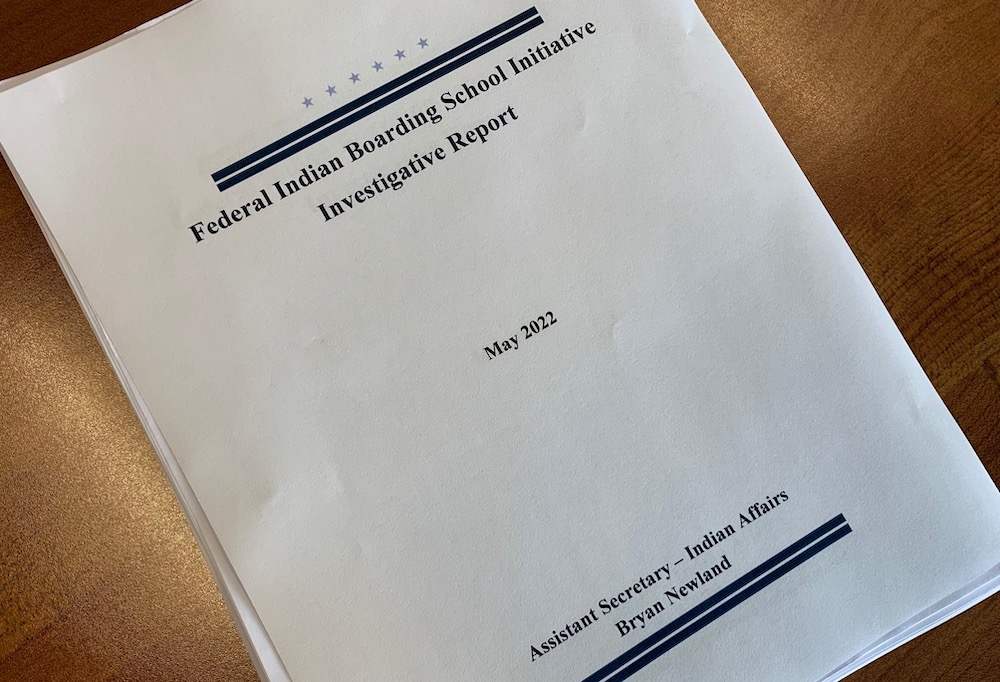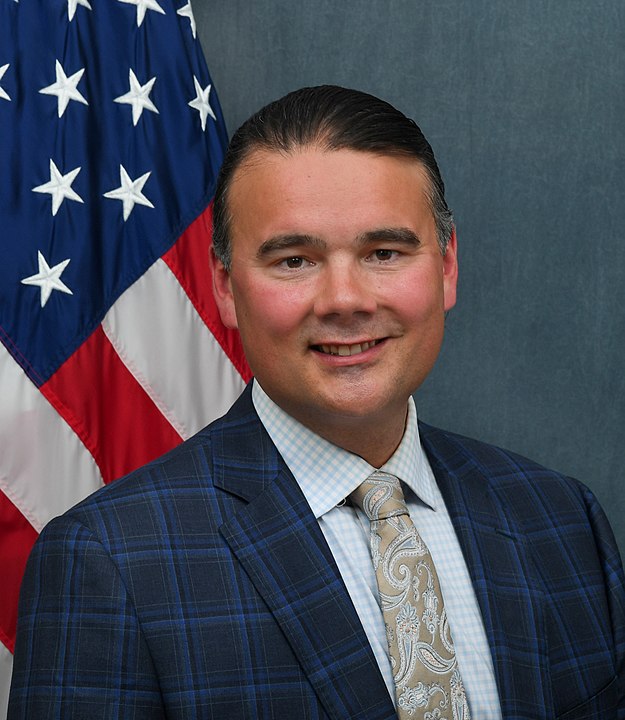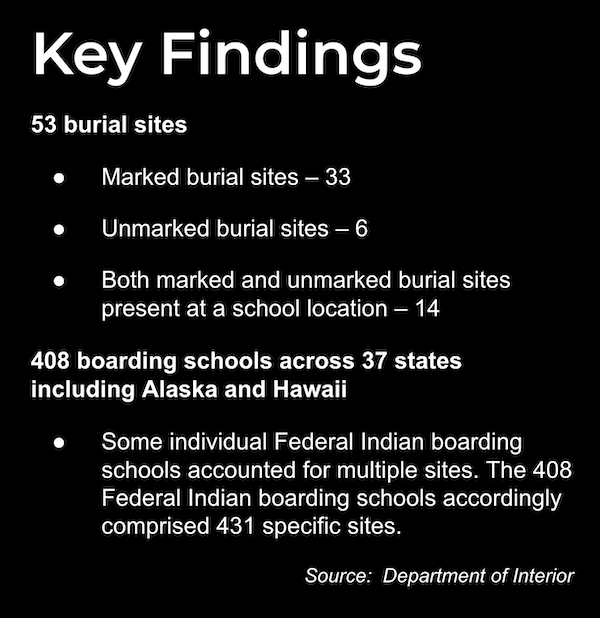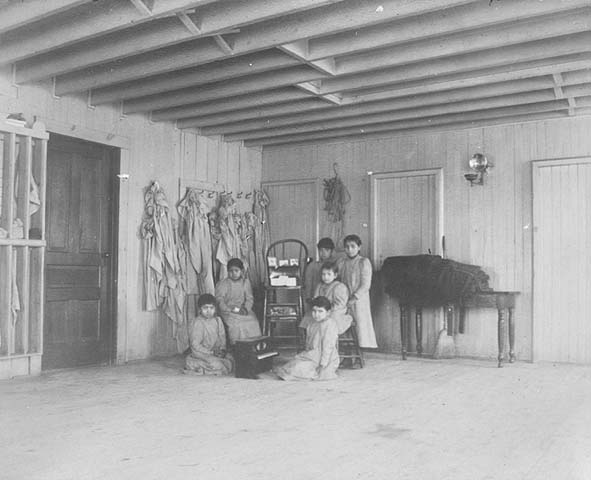
- Details
- By Jenna Kunze
The U.S. Department of the Interior (DOI) today released its initial findings after a nine-month investigation into the fraught legacy of Indian Boarding Schools that the U.S. government ran or supported for a century and a half.
The 106-page report—penned by Assistant Secretary of Indian Affairs Bryan Newland—details for the first time that the federal government operated or supported 408 boarding schools across 37 states, including Alaska and Hawai’i, between 1819 and 1969. About half of the boarding schools were staffed or paid for by a religious institution. The investigation identified marked and unmarked burial sites at 53 of those schools, though the DOI expects to find the number of children buried at boarding schools across the nation to be in the “thousands or tens of thousands,” as the investigation continues.
The DOI also identified more than 1,000 additional federal and non-federal institutions that didn’t fall under its definition of “federal Indian boarding school.” Those additional institutions such as Indian day schools, sanitariums, asylums, orphanages, and stand-alone dormitories worked similarly to assimilate Native youth into white society.
“The consequences of federal Indian boarding school policies—including the intergenerational trauma caused by the family separation and cultural eradication inflicted upon generations of children as young as 4 years old—are heartbreaking and undeniable,” said Secretary of the Interior Deb Haaland. “We continue to see the evidence of this attempt to forcibly assimilate Indigenous people in the disparities that communities face. It is my priority to not only give voice to the survivors and descendants of federal Indian boarding school policies, but also to address the lasting legacies of these policies so Indigenous peoples can continue to grow and heal.”
“This report confirms that the United States directly targeted American Indian, Alaska Native, and Native Hawaiian children in the pursuit of a policy of cultural assimilation that coincided with Indian territorial dispossession,” Newland wrote in a letter to Haaland along with his submission of Volume 1 of the investigative report on April 1. “I believe that this historical context is important to understanding the intent and scale of the Federal Indian boarding school system, and why it persisted for 150 years.”
 Bryan Newland, Assistant Secretary of the Interior for Indian Affairs. (Photo/Department of Interior)With its boarding school policy, the U.S. government hoped that assimilating Native youth would allow it to gradually break up tribal lands into allotments out west, making it easier and less expensive than war to take Tribal lands in the West.
Bryan Newland, Assistant Secretary of the Interior for Indian Affairs. (Photo/Department of Interior)With its boarding school policy, the U.S. government hoped that assimilating Native youth would allow it to gradually break up tribal lands into allotments out west, making it easier and less expensive than war to take Tribal lands in the West.
At these federal Indian boarding schools, Indigenous childrens’ identities, languages, and beliefs were forcibly suppressed through “systematic militarized and identity-alteration methodologies,” the report reads. Upon entry, children immediately had their hair cut, were reassigned English names, and were forbidden from speaking their Native languages or practicing their cultures.
Most of the boarding schools used Indigenous youth for manual labor to compensate for poor school conditions and lack of sufficient federal funding. Rules at the institutions were often enforced through punishment, “including corporal punishment such as solitary confinement; flogging; withholding food; whipping; slapping; and cuffing.”
Interior Secretary Deb Haaland announced the Federal Indian Boarding School Initiative last June, in response to the discovery of 215 unmarked graves by Canada’s Tk’emlúps te Secwepemc First Nation at the Kamloops Indian Residential School.
The investigation’s primary goals were to identify boarding school locations, burial sites, and the names and tribal affiliations of children interred at each location.
So far, the investigation has achieved just one of those goals: naming and locating boarding school sites throughout the country. They were able to glean this information from the National Native American Boarding School Healing Coalition (NABS), which shared their decade-long work with the Department of Interior.
 The DOI signed a memorandum of understanding with NABS in December 2021 to access their research. Included in that research was the working list of federal Indian boarding schools throughout the country, created by the organization’s co-founder and former board president, Denise Lajimodiere. As of July 2021, Lajimodiere—with the input of other researchers—had named 406 boarding schools across 31 states, according to records she sent Native News Online.
The DOI signed a memorandum of understanding with NABS in December 2021 to access their research. Included in that research was the working list of federal Indian boarding schools throughout the country, created by the organization’s co-founder and former board president, Denise Lajimodiere. As of July 2021, Lajimodiere—with the input of other researchers—had named 406 boarding schools across 31 states, according to records she sent Native News Online.
As for a comprehensive list of student burial sites related to the schools and the identities of children buried there, the DOI said it had more work to do. Investigators were limited by COVID-19 restrictions and funding, Newland wrote.
Congress appropriated $7 million in new funding in fiscal year 2022 for the DOI to continue its investigation. The DOI did not respond to Native News Online’s request on how much money was appropriated to the investigation.
Newland concluded that further investigation is required to determine the legacy impacts of the boarding school era on tribal communities today.
He recommended a second report that specifically focuses on investigative findings of locations of marked or unmarked burial sites associated with the Federal Indian boarding school system; names, ages, and tribal affiliations of children interred at such locations; and an estimation of federal dollars spent supporting the Federal Indian boarding school system as well as Native land held in trust by the United States used to support the Federal Indian boarding school system.
Additionally, Newland made eight recommendations to the Secretary of the Interior to fulfill the Federal Indian Boarding School Initiative, including: identifying surviving boarding school attendees and documenting their experiences; supporting the protection and preservation of boarding school sites where the federal government has jurisdiction; and to authorize agencies disinter or repatriate any remains of Native children—with direction from their respective tribe, community, or family—discovered in marked or unmarked burial sites associated with the Federal Indian boarding school system.
Newland also recommended the DOI develop a specific repository of Federal records involving the Federal Indian boarding school system at the Department of the Interior Library.
“This report, as I see it, is only a first step to acknowledge the experiences of Federal Indian boarding school children,” Newland wrote. “It notes a desire from people across Indian Country and the Native Hawaiian Community to share their individual and family experiences within the Federal Indian boarding school system and the resulting impacts today. This report also presents an opportunity for us to reorient our Federal policies to support the revitalization of Tribal languages and cultural practices. This reorientation of Federal policy is necessary to counteract nearly two centuries of Federal policies aimed at the destruction of Tribal languages and cultures. In turn, we can help begin a healing process for Indian Country and the Native Hawaiian Community, and the United States, from the Alaskan tundra to the Florida everglades, and everywhere in between.”
Today at 12:30 p.m. ET, Newland, along with Secretary Haaland, will host a press conference to address the report and progress on the Federal Indian Boarding School Initiative.
This story has been updated to include a quote from Secretary of the Interior Deb Haaland.
 Native American boarding school students posed in room. (Photo/WikiCommons)
Native American boarding school students posed in room. (Photo/WikiCommons)
Tell Us What You Think
More Stories Like This
Native News Weekly (August 25, 2024): D.C. BriefsUS Presidents in Their Own Words Concerning American Indians
2026 Native American 40 Under 40 Class Announced
Monday Morning: (January 5, 2026): Articles You May Have Missed This Past Weekend
Native News Weekly (January 4, 2026): D.C. Briefs
Help us defend tribal sovereignty.
At Native News Online, our mission is rooted in telling the stories that strengthen sovereignty and uplift Indigenous voices — not just at year’s end, but every single day.
Because of your generosity last year, we were able to keep our reporters on the ground in tribal communities, at national gatherings and in the halls of Congress — covering the issues that matter most to Indian Country: sovereignty, culture, education, health and economic opportunity.
That support sustained us through a tough year in 2025. Now, as we look to the year ahead, we need your help right now to ensure warrior journalism remains strong — reporting that defends tribal sovereignty, amplifies Native truth, and holds power accountable.
 The stakes couldn't be higher. Your support keeps Native voices heard, Native stories told and Native sovereignty defended.
The stakes couldn't be higher. Your support keeps Native voices heard, Native stories told and Native sovereignty defended.
Stand with Warrior Journalism today.
Levi Rickert (Potawatomi), Editor & Publisher

